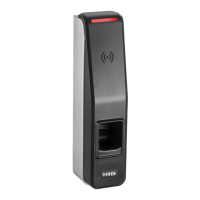Term Definition
Authentication Mode
(Signo 25B)
Template on Card: The Signo 25B is waiting for a Credential (Card) to be
presented. It retrieves all the biometric templates from the credential.
If the presented finger matches the biometric templates retrieved from
the credential a Grant Access is recommended. This is a 1:1 Verification
match against Template on Card (TOC). The sensor is not armed (blue
light off) until the Credential is presented.
Card + Finger: The Signo 25B is waiting for a Credential (Card) to be
presented. It looks up the user ID and all associated biometric templates
in it’s local device database. If the presented finger matches the
biometric templates retreated from the local database a Grant Access is
recommended. This is a 1:1 Verification match against Template on
Device (ToD). The sensor is not armed (blue light off) until the Credential
is presented.
Finger Only: The Signo 25B is waiting for a finger to be presented that is
stored in its local device database. If the presented finger matches one
stored in the database a Grant Access is recommended. This is a 1:N
Identification match against Template on Device (ToD). The sensor is
always armed (blue light on).
Card Only: The Signo 25B is waiting for a Credential (Card) to be
presented. It reads the PACS data only and always recommends a Grant
Access. The sensor is never armed (blue light off).
Card Only (or) Finger Only: The Signo 25B is waiting for either a
Credential (Card) to be presented or a finger, stored in its local device
database, to be presented. This authentication mode is particularly useful
during initial enrollment setup.
Biometric spoofing Biometric spoofing is a method of fooling a biometric identification management
system. An artificial object (for example, a fingerprint mold made of silicon) is
presented to the biometric scanner that imitates the unique biological properties of
a person which the system is designed to measure.
BLE Bluetooth Low Energy (formerly marketed as Bluetooth Smart) is a wireless
personal area network technology.
ERR The Equal Error Rate (EER) is the common value indicating that the proportion of
false acceptances (FAR) is equal to the proportion of false rejections (FRR). The
lower the EER value, the higher the accuracy of the biometric system.
False Accept Rate (FAR) The False Accept Rate (FAR) is the measure of the likelihood that the biometric
security system will incorrectly accept an access attempt by an unauthorized user.
False Reject Rate (FRR) The False Reject Rate (FRR) is the instance of a security system failing to verify or
identify an authorized person.
FTA Failure To Acquire. The biometric system failure to extract usable identification
data from a biometric sample.
Identification (of Identity) Typically finding a matching template in a large database of templates. 1:N
matching.
LFD Live Finger Detection. This is used in some markets instead of Spoof. It is also used
to refer to insuring a severed finger is not being presented at the sensor.
PLT-04900, B.1 15 March 2021
Powering
Trusted Identities
HID® Signo™ Biometric Reader 25B
User Guide

